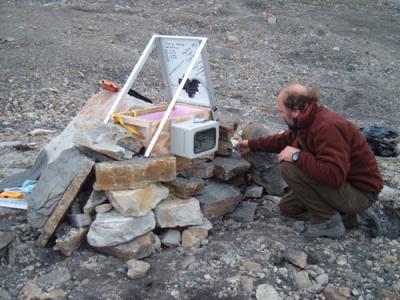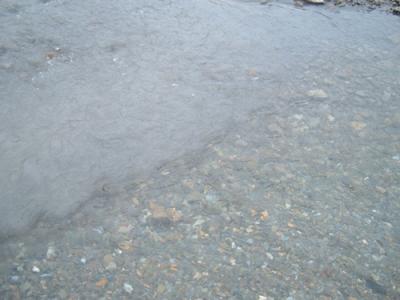
Monday’s weather called for rain. This is, after all, Svalbard’s rainy season. We woke to overcast, but no rain. It came eventually but was usually light and manageable. This has been a dry weather pattern around here the past couple of weeks and it interested the team to see how a fresh pulse of water would influence the inlet stream and sediment rates.
Steve Roof and I hiked up to his remote camera on a rock ridge about 100 meters above the lake on the east side. This camera, dubbed "Plume Cam”, takes pictures of the water flow into the lake from the inlet, which is fed from the glacier. It takes a picture every 3 hours every day, all year (except those times of the year when it is always dark. Their NSF grant doesn’t fund for a flash THAT big!). The idea is to capture the specific times of the year when the sediment flow is the greatest. It may seem like a no-brainier that it would be during the snow melt of the spring, but remember, snow from the valley and on top of the glacier is only a small part of the water cycle in this valley. The glacier is the main hydrologic driver here. Steve, Mike and Al would like to know if the glacier is dumping big or steady or inconsistent pulses of water and sediment into the lake. And, if this happens through the summer, or is more or less isolated during a particular time. We know that glaciers expand and retreat over time, but is this glacier loosing more ice than it is gaining (it is), but how fast and when particularly? The plume cam, along with the sediment traps, temperature, water temperature, ice depth and yes, the "GlacierA mass of ice that persists for many years and notably deforms and flows under the influence of gravity. Cam” data analyzed together will help paint the whole picture of a pattern of change over time. And When I say "time” I mean the last nine thousand years, which includes the rapid deglaciation that has occurred in this valley in the past 90 years.
A good day spent up high over looking the water and with good company. Steve is not only a very good scientist; he is very funny as well. Tuesday calls for warmer weather and partly cloudy. Time for a trip up valley to service the "GlacierA mass of ice that persists for many years and notably deforms and flows under the influence of gravity. Cam”!



Comments